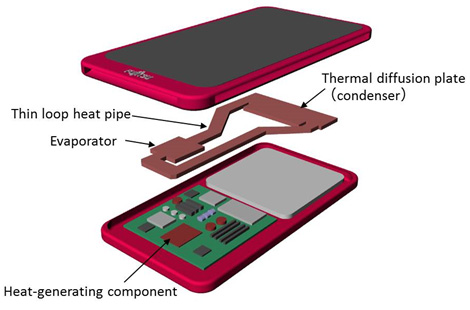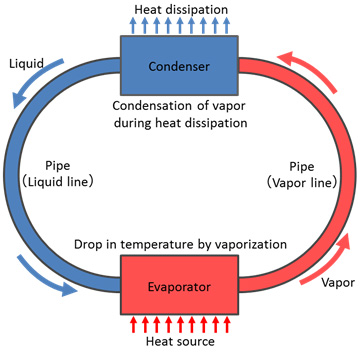Fujitsu bringing liquid cooling to smartphones and tablets by 2017
While the modern smartphones are amazing at what they do and come with powerful hardware, they tend to get hot, really really hot. There are rumors that Snapdragon 810 can get unbearably hot and that HTC One M9 gets insanely hot too. Fujitsu Laboratories Ltd. has announced today that they finished development of world’s first thin cooling device that is designed for small electronic devices. This new tech can help OEMs run CPUs and other heat generating components to run much cooler and can even clear concentrated hot-spots in these devices. The bad news though is that this will not be made mainstream till the year 2017.


As of today, the heat dissipation is done using simple heat pipes. These heat pipes absorb heat from CPU etc and spread it even across. Fujitsu has developed a thin loop heat pipe that can transfer nearly five times the heat that current gen thin heat pipes can transfer. Given that the heat pipes are less than a millimeter thick, OEMS should not worry about phone’s thickness. Details of this technology are being presented at the Semiconductor Thermal Measurement, Modeling and Management Symposium 31 (SEMI-THERM 31), opening March 15 in San Jose, California.
The loop heat pipe consists of an evaporator, a condenser and a coolant. Evaporator abosorbs heat from the source and condenser dissipated the heat from the evaporator. The two components are connected by pipes and are filled with coolant. When the coolant reaches the evaporator, it t evaporates due to the heat and the energy consumed due to this results in cooling the heat source.
Features of the technology as explained by Fujitsu
1. Structural design for high-efficiency heat transfer
Heat transfer using a loop heat pipe is based on the same sort of capillary action that absorbs water in fibers, sponges, and plants. The evaporator contains a porous structure, with the numerous holes driving the fluid with capillary action. To achieve this action, Fujitsu stacked together copper sheets to develop a structure containing minuscule pores. The pattern of holes etched into the sheets is such that the holes of each layer are slightly offset from the adjacent layers. When these sheets are stacked, capillary action is created that causes the fluid to circulate. In addition, by separating the vapor phase and liquid phase, there are two flows of the working fluid within the stacked structure, which enables efficient heat transfer. Furthermore, because the liquid line that returns fluid to the evaporator operates on capillary action, enabling it to stably transfer heat regardless of the device’s orientation, this technology can now be applied to mobile devices.
2. Thinner loop heat pipe
This loop heat pipe uses copper sheets that are only 0.1 mm thick, with two surface sheets and four inner-layer sheets, for a total of six sheets. The previous, approximately 10 mm thick evaporator of the loop heat pipe can now be reduced to 0.6 mm, enabling a heat-transfer device to be equipped to compact mobile devices.



